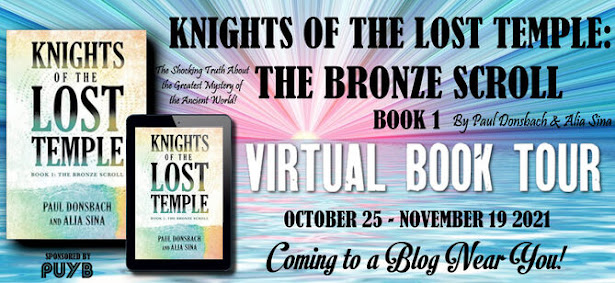The Bronze Scroll, An Adventure-Romance Novel Based On
A True Story Solving The Greatest Mystery of the Ancient World…
By Paul Donsbach & Alia Sina
KNIGHTS OF THE LOST TEMPLE: THE BRONZE SCROLL, Adventure/Romance, 300 pp.
The authors of The Bronze Scroll are excited to announce the publication of their first book in the Knights of the Lost Temple adventure-romance series. This groundbreaking novel, co-authored by Paul Donsbach and Alia Sina, tells the story of Sam Romero, an investigative attorney who has uncovered and solved hundreds of high-profile corporate crimes and scandals. But nothing has prepared Sam for the mysteries of his latest investigation—an ancient treasure map stolen by corporate thieves, an Israeli land-permitting official murdered, and a local reporter kidnapped and held hostage by a rogue executive, Roy Griffin III. Racing against the clock to rescue the beautiful reporter, Rebecca Schreiber, Sam has only hours to prove that he can solve the mysteries of an ancient bronze scroll and find the Temple treasures hidden during a time of war.
“We want to surprise our readers with stories of making the ‘impossible’ become real,” said co-author Mr. Donsbach. “The world is truly ours to remake with a vision of unity, diversity, and inclusion. Through our fictional characters, we will work to show that “ordinary” people can accomplish seemingly miraculous feats through friendship, inspiration, and love. In fact, history teaches that this is the only way that positive change happens. “
Remarked co-author Alia Sina on creating their book: “While on our own separate journeys, we found ourselves working on a story that flowed with ease given each of our strengths that complimented one another in the world of fiction. We each were working on our own novel and, at the suggestion of our moderator for our writers’ workshop, we began working with each other. What was intended to simply be an “experiment/project/let’s see what happens” turned into a commitment we both developed to the characters and their story. As a fan of supernatural suspense novels, and now as an author, it never ceases to amaze me how real the characters could become. Having written my first novel with Paul, I feel the characters waiting to continue their story.”
A New-Age Journey of Discovery: For their first novel in the Knights of the Lost Temple series, co-authors Paul and Alia chose the so-called Copper Scroll (which is actually made of bronze) as a central element in the characters’ story. One of the Dead Sea Scrolls found in a desert cave in the 1950s, this artifact is a treasure map listing tons of gold and silver hidden at vaguely described locations that scholars had given up on deciphering. As a supposedly “unsolvable” mystery, the Copper Scroll would serve a symbol of the discontents of modern life, in which the great, achievable dreams seem to have already been accomplished.
There was just one problem. The Copper Scroll wasn’t unsolvable after all. As Sam and his friends work to decipher this ancient treasure map, its mysteries unravel one by one. By searching for the listed treasure descriptions in the e-book version of the ancient historian Flavius Josephus’ writings, Sam and his friends discover that most of the treasure sites involve metaphors or legends important to the leaders of the Judean provisional government at the outbreak of the Great Revolt in 66 CE. They realize that this treasure map must have been made for a peace speech before the Bronze Gate to the Jerusalem Temple in May of that year, in which one of the leaders (probably the chief high priest) urged negotiations with the Romans to end the revolt.
The high priest’s speech would have begun with treasure site 1—seventeen talents (about 900 pounds) of gold and silver hidden in the Valley of Achor. This matches the seventeen talents of gold and silver that Josephus recorded as being stolen from the Temple by the Roman governor, triggering the revolt. As the high priest would explain to his audience, the Valley of Achor was a biblical location where a thief was executed for stealing gold and silver from the Temple. Having condemned the Roman governor in this manner at the beginning of his speech, the high priest would move on to the other metaphors in the treasure sites listed on the Copper Scroll, including the 900 talents (sites 3, 56 and 58) that Josephus identified as the annual taxes paid to Rome by Judea and the other Jewish client states, and the 300 talents of gold (site 47) that Josephus described as being allocated by King David for his son Solomon’s use in building and furnishing the inner sanctuary of the Temple.
A Sacred Relic of the Exodus from Egypt: As they decipher this ancient treasure map, Sam and his friends realize that the 300 talents of gold that site 47 says were hidden underground on the west side of the Pool of Siloam match another legend of hidden Temple treasures being recorded on a bronze scroll. They learn of a legendary account in the so-called Treatise of the Vessels of a bronze scroll being made during a time of crisis, as a permanent record of King Hezekiah, or one of the other listed leaders, hiding the Ark and the gold from Solomon’s Temple in an underground cistern near the Gihon Spring (the water source adjoining the Pool of Siloam), to be revealed at the time of the Messiah, son of David.
But, the characters wonder, is this what treasure site 60 means when it says that the Book of Kohelet (Ecclesiastes) is the “deciphering scroll” explaining each of the hidden treasures? After all, its famously enigmatic epilogue (chapter 12) cryptically refers to the Exodus story (almond blossoms and locusts), the Tabernacle (a silver cord and a golden pitcher), a spring and a cistern, and “every hidden thing,” to be revealed at the time of judgment. Could this be a secret biblical code recording that the lost Ark and the gold from Solomon’s Temple were hidden in a underground cistern by the Pool of Siloam near the Gihon Spring?
A Time for Peace: As the adventurous Bronze Scroll novel moves toward its surprise ending, the characters decipher more of the Copper Scroll’s metaphorical treasure descriptions (including the cursed son of King David at site 48, the Samaritans’ version of the lost Ark legend at site 57, and the bronze sacrificial altar at site 59). Using mysterious spiritual powers that he has long resisted, and the protection of a secret knighthood that he discovers, Sam must learn the scroll’s remaining mysteries before Roy makes good on his threats. He must learn the explosive truth needed to save Rebecca and, in the process, uncover the true spiritual meaning of this ancient bronze scroll.
But what could that be? Is it Kohelet’s message about a “time for peace”? Or does an ancient scroll found soon after modern Israel’s independence tell us something about the time of judgment? As the Knights of the Lost Temple series begins with this first novel, Sam and his friends start an exciting journey of discovery in search of this hidden truth.
The authors of this new adventure-romance series invite you to join them on this voyage. Currently working on the second book in the series, the authors believe that the world’s diverse spiritual traditions hold answers for our troubled times. Paul, who identifies as “spiritual but not religious,” and Alia, a “new-age Muslim” from an Afghan American family (writing under her pen name), believe that greater understanding among the world’s different faiths and beliefs is essential to solving the world’s current problems. Recognizing that even the smallest miracles—like an ancient treasure map found in a desert cave—can make a big difference, the authors welcome you to share this journey together.
For More Information:
Publication date: August 11, 2021, 291 pages; an independent publication of Knights of the Lost Temple, LLC.
E-book: $9.99; 978-1-7373978-0-9
Paperback: $19.99; 978-1-7373978-1-6
Hardback: $29.99; 978-1-7373978-2-3
Book website: https://www.knightsofthelosttemple.com/
Rebecca’s blog (under pen name): https://veilsofdesire.com/
Amazon Selling Page: https://amzn.to/3BcelQr
Facebook: https://www.facebook.com/Knights-of-the-Lost-Temple-105963305136800
Instagram: https://www.instagram.com/knightsofthelosttemple/
Note from author: One of our favorite excerpts comes from page 9. The protagonist, Sam Romero, has just explained the “unsolvable” Copper Scroll to the old man sitting next to him on the flight to Rome. He told the old stranger that the scroll is an ancient treasure map that has been written off as undecipherable. Then Sam explains that he thinks he can solve it:
Co-author Paul Donsbach is a Texas native and a lawyer. Raised in an era when those working for social progress were rooted in religious faith, he believes that many of today’s problems likewise require a renewed commitment to spiritual ideals.
Co-author Alia Sina was born and educated in the greater San Francisco Bay area. She was raised in a first-generation, close-knit Afghan American family. Some of her formative experiences involved her interactions with people who embrace cultural diversity, as well as those who are hostile to families from a different background.
For More Information:
Book website: https://www.knightsofthelosttemple.com/
Rebecca’s blog (under pen name): https://veilsofdesire.com/
Facebook: https://www.facebook.com/Knights-of-the-Lost-Temple-105963305136800
Instagram: https://www.instagram.com/knightsofthelosttemple/











































